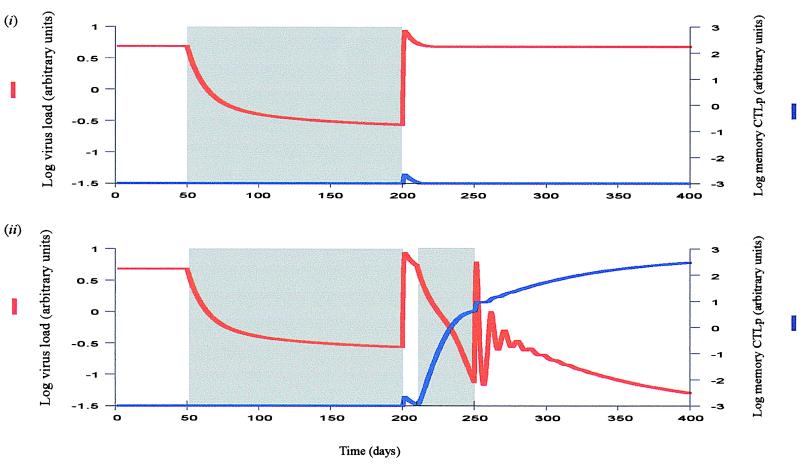Figure 3.
Asymptomatic period of the infection. Shading indicates drug therapy. (i) Efficient drug therapy reduces virus load to low levels. However, if the drugs are withdrawn, virus load re-emerges to pretreatment levels. Although the rise in virus load boosts the immune system, virus-induced immune impairment prevents the development of CTL memory. Note again, that we only consider memory CTLp as defined in the text, dependent on the presence of CD4 cell help. Hence, before therapy, the figure does not show persistence of less efficient CTL at higher levels that may not control the infection in the long term and that may be maintained by continuous viral replication in HIV-infected patients. (ii) Treatment regime required to re-establish CTL memory. It consists of four phases: The first phase of treatment reduces virus load to low levels, which is followed by a drug holiday allowing the virus to replicate, thereby boosting the immune system. While virus load increases, the secondary phase of therapy is initiated. This phase suppresses the amount of virus-induced immune impairment and allows the establishment of CTL memory in response to the increased virus load. Finally, drug therapy can be stopped for good once CTL memory has been generated. The virus now is controlled in the long term by the immune system. Note that after the second phase of therapy virus load transiently rises and oscillates before being controlled by CTL memory, because during the second phase of therapy the CTL effector response will have declined to low levels, allowing the virus to initially attain a positive growth rate. However, this does not indicate failure of the treatment regime. Furthermore, it is important to point out that the secondary phase of treatment reduces virus load to lower levels in a shorter period of time than the primary phase of treatment, because the secondary phase of treatment is associated with a rising CTL memory response that accelerates the death rate and consequently the decay rate of infected cells during therapy. This finding underlines the notion that the effect of drug treatment on virus load is enhanced by the presence of an efficient CTL response (41). Parameters were chosen as follows: λ = 1; d = 0.1; β = 0.5; a = 0.2; p = 1; c = 0.1; b = 0.01; q = 0.5; h = 0.1; s = 0.0042.

